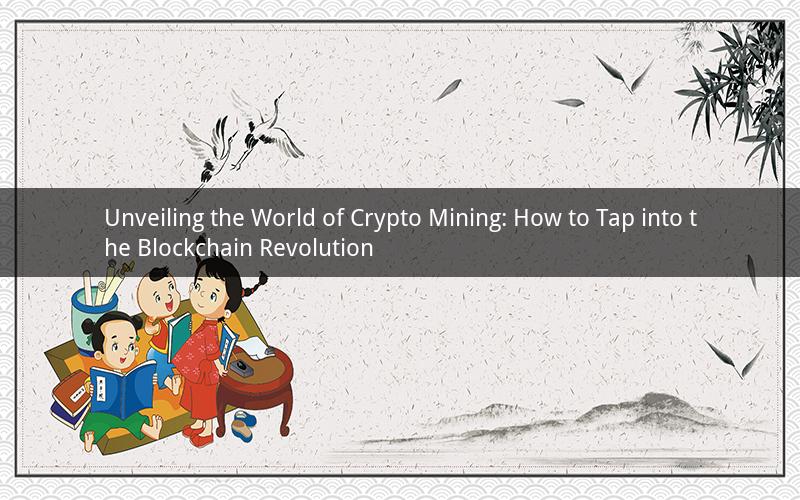
Introduction:
Cryptocurrency mining has become a popular and intriguing activity for individuals looking to earn digital coins. With the rise of blockchain technology, mining has become more accessible than ever. In this article, we will delve into the world of crypto mining and explore how you can get started. We will discuss the necessary hardware, software, and steps involved in mining, as well as the potential risks and rewards.
1. Understanding Crypto Mining
Crypto mining is the process of validating and adding new transactions to a blockchain. Miners use powerful computers to solve complex mathematical puzzles, and in return, they receive cryptocurrency rewards. This process ensures the security and integrity of the blockchain network.
2. Choosing the Right Hardware
The hardware you choose for crypto mining plays a crucial role in its success. Here are some key factors to consider:
a. GPU vs. CPU: Graphics Processing Units (GPUs) are generally more efficient than Central Processing Units (CPUs) for mining. GPUs can handle more calculations simultaneously, making them suitable for mining.
b. ASIC Miners: Application-Specific Integrated Circuits (ASIC) miners are designed specifically for mining and offer higher performance than GPUs. However, they are more expensive and less versatile.
c. Power Supply: Ensure that your hardware has a reliable power supply unit (PSU) to prevent overheating and damage to your components.
3. Selecting a Mining Pool
Mining pools are groups of miners who work together to increase their chances of finding a block and earning rewards. Here's how to choose a mining pool:
a. Reputation: Research the reputation of mining pools to ensure they are reliable and trustworthy.
b. Fees: Some mining pools charge fees for their services. Choose a pool with reasonable fees to maximize your profits.
c. Payout Methods: Consider the payout methods offered by mining pools and choose one that aligns with your preferences.
4. Setting Up Your Mining Rig
Once you have your hardware and a mining pool, it's time to set up your mining rig. Follow these steps:
a. Assemble the Hardware: Connect your GPU or ASIC miner to your PSU and motherboard.
b. Install the Operating System: Install a lightweight operating system like Ubuntu or Windows Server to run your mining software.
c. Install Mining Software: Download and install mining software compatible with your hardware and mining pool.
5. Optimizing Your Mining Rig
Optimizing your mining rig can improve its performance and efficiency. Here are some tips:
a. Cooling: Ensure proper airflow and cooling solutions to prevent overheating.
b. Overclocking: Carefully overclock your hardware to increase its performance. However, be cautious as this may void warranties and lead to instability.
c. Monitoring: Use monitoring tools to track your rig's performance and adjust settings accordingly.
6. Staying Informed
The crypto market is highly volatile, so staying informed is crucial. Here are some ways to keep up with the latest trends:
a. Follow crypto news websites and social media channels.
b. Join online communities and forums to connect with other miners.
c. Attend crypto conferences and meetups to network with industry professionals.
7. Risks and Rewards
While crypto mining can be lucrative, it's important to be aware of the risks involved:
a. Market Volatility: Cryptocurrency prices can fluctuate significantly, impacting your earnings.
b. Hardware Costs: Mining hardware can be expensive, and the initial investment may not be recouped immediately.
c. Energy Consumption: Mining rigs consume a substantial amount of electricity, leading to higher energy bills.
Despite these risks, the potential rewards can be substantial, especially if you start mining when prices are low and sell your coins when they reach peak levels.
FAQs:
1. Q: Can anyone mine cryptocurrency?
A: Yes, anyone with the necessary hardware and internet connection can mine cryptocurrency.
2. Q: Is it profitable to mine cryptocurrency?
A: Profitability depends on various factors, including hardware efficiency, electricity costs, and market conditions.
3. Q: Can I mine multiple cryptocurrencies with the same hardware?
A: Some hardware is versatile and can mine multiple cryptocurrencies. However, different coins require different algorithms, so you may need to switch your mining software accordingly.
4. Q: How long does it take to mine a block?
A: The time it takes to mine a block varies depending on the cryptocurrency and the difficulty level of the network. For Bitcoin, it takes approximately 10 minutes to mine a block.
5. Q: Is crypto mining legal?
A: Crypto mining is legal in most countries, but it's important to check the laws and regulations in your specific region to ensure compliance.
Conclusion:
Mining cryptocurrency can be an exciting and potentially profitable endeavor. By understanding the process, selecting the right hardware, and staying informed about market trends, you can maximize your chances of success. Remember to stay cautious of the risks involved and always research thoroughly before diving into the world of crypto mining.